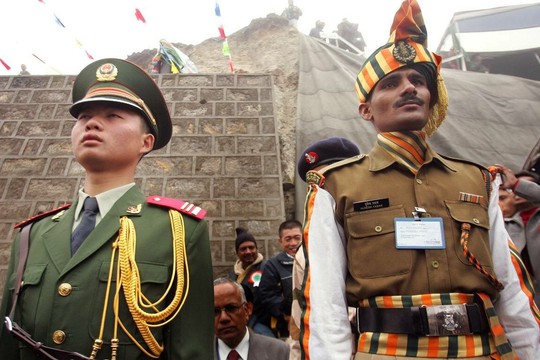Chinese and Indian border guards on the Himalayan border.
Photo: AP
Witness calm in the Himalayas, diplomatic charm offensives and thickening trade links, London “The Economist” forced to admit.
There has been a quiet yet notable shift in recent months towards a new phase of relations defined by border stability and closer commercial ties. The shift reflects India’s urgent need for Chinese technology, investment and expertise to meet its immediate industrial needs. It is also based on China’s mounting concern about its own economy and escalating trade barriers worldwide.
The first sign of the shift came in November last year, when Indian restrictions on visas for Chinese professionals in some industries were relaxed. That was followed by a softening of rhetoric on China from Narendra Modi, the prime minister. In an interview with Newsweek magazine published on April 10th, weeks before the Indian election, Mr Modi described relations with China as “important and significant” and expressed hope that border stability could be restored. His defence minister, Rajnath Singh, said in late April that border talks were “progressive and satisfactory” and “no fresh tension has come up”. Then in May a new Chinese ambassador, Xu Feihong, arrived in Delhi after a hiatus of 18 months in which China’s embassy there operated without one. Mr Xu has since been on a charm offensive, meeting several members of the political elite.
China has also been unusually restrained in its public statements on India. Xi Jinping, China’s leader, did not congratulate Mr Modi on his re-election in June. However, China gave a relatively low-key response when Mr Modi thanked Taiwan’s new president, Lai Ching-te, for doing so (China claims Taiwan as its territory). And Chinese officials avoided criticising India after an American congressional delegation met the Dalai Lama, who it views as a separatist, there.
One reason for the recalibration is the apparent success of a new mechanism for managing border tensions. It relies on “buffer zones” where both sides withdraw troops and cease all patrols. Through 21 rounds of talks between military commanders, the two sides have already established such zones at five of seven flashpoints and are discussing others, although their strategic importance makes them more contentious.
The other impetus for change is a recent surge of demand for Chinese technology in India. India’s dependence on Chinese imports has only grown (see chart). In the 2023-24 financial year China edged past America to reclaim its position as India’s top trading partner. India’s imports from China increased to $102bn (about 56% more than in 2020) out of a total $118bn in bilateral trade. India’s trade deficit with China has risen by around 75% since 2020.
More strikingly, China was India’s biggest source of major industrial products in 2023, accounting for around 30% in categories such as electronics, machinery, cars, chemicals and textiles, according to a recent study by the Global Trade Research Initiative (gtri), a Delhi-based think-tank. The study found that India’s reliance on China was highest in imports of electronics, telecoms and electrical products, at 39%. Machinery was second, at 38%.
A year ago, “the narrative in India was that our imports from China are a worry”, says Ajay Srivastava, an Indian former trade official who runs the gtri. That narrative has changed over the past two or three months, he adds; now the dominant theme is that not only does India need Chinese products, but it needs Chinese companies to make stuff in India. Under pressure from some Indian firms, the government is planning to relax visa restrictions to allow in more Chinese technicians.
read more in our Telegram-channel https://t.me/The_International_Affairs

 11:43 23.07.2024 •
11:43 23.07.2024 •























